Carretera Austral Part 2: Puerto Montt and Hornopirén
Originally posted to El Cantar de la Lluvia on Monday, March 05, 2007
Despite having gone to bed late, I woke up early. The tent was not sunlit. I could hear a soft, constant noise, the occasional crinkle of a plastic bag at another campsite, the clink of a fork a few tents off. What was that soft, constant noise then? My consciousness drifted here and there, compared it to the sound a TV makes when it gets no signal, and promptly shut down for another five minutes of dozing. My eyes popped open wide when I understood what the noise was: rain. Crap. That meant that we'd have to take everything apart and pack in the rain.
We did, and it was quite unpleasant. Somewhere in the pile of stuff that we had on top of and below the campsite's table (both slightly drier than everywhere else thanks to a tree) was my inflatable bed roll. I got it as a Christmas present, it's one of those thin ones that self-inflate. A few days later I realised I had lost it, most certainly hanging in the tree or tucked out of the rain under the table.
Wet and uncomfortable in our yellow rain suits, we set off. We didn't want to have anything to do with the scenery, turnoffs, tourist stops. We just wanted to get there as soon as possible.
And we did. Stopping at service stations every now and then, for food or fuel. On one of those stops some naive soul, glancing at the half-donned rain suits as we munched some food, actually asked Camilo if we were motorcycle delivery people. Ah, the wonders and mysteries of thy neighbour's mind...

One thousand kilometres from Santiago, and night fell.

We rode in to Puerto Montt quite late, and weren't too thrilled at what we managed to see of the city. We decided to stay at a hotel (Millahue), so we could dry our things and get good rest before the main leg of the journey. It was still raining.
The next morning we trudged over to the Easy home maintenance store to buy a few things. I got the unpleasant surprised that my waterproof gators, needed to complement my short touring boots, had had some sort of existential crisis, and were no longer waterproof. It seems the rubberized backing just dissolved. I wonder why, since they weren't a year old.
I decided to buy a few metres of polyethylene, transparent contact glue, 3M two-sided outdoors sticky tape. The plan was to extend my rain suit's trousers with all of this, since they rode up whenever I was on the bike. Camilo bought kitchen gloves (yes, those yellow rubber ones), since his gloves were getting soaked.
Before we left the room, I noticed that roof of the building next to the hotel had been used for some strange re-decorating sessions.
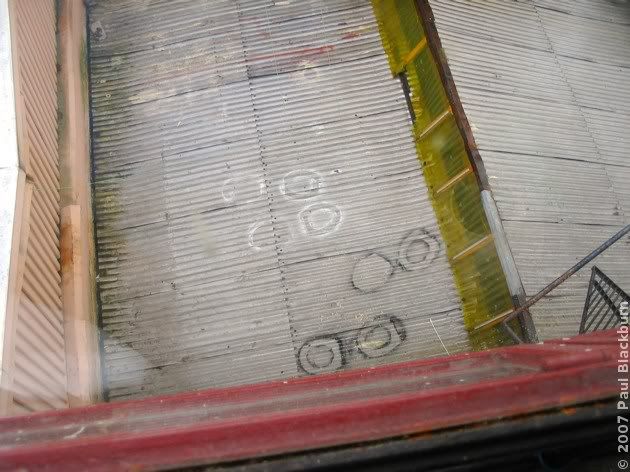
We set off in the rain towards Hornopirén. We were finally on the Camino Longitudinal Austral, the Ruta 7. We didn't know what to expect: mud, holes, washboard, giant rocks.
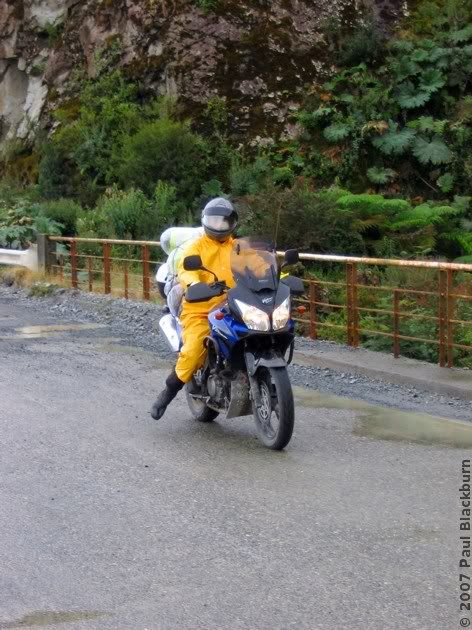
After about 60 km of riding we reached Caleta La Arena, where we took the first ferry. The queue of vehicles was quite long, but we just buzzed straight down to the loading ramp. Ah, the beauty of motorbikes. If you can't do this sort of thing where you live, it's time to pack up and ride across a border or two.
We bought the last empanadas we'd see for a while, which we had not time to finish before El Trauco came in.

It rained still.
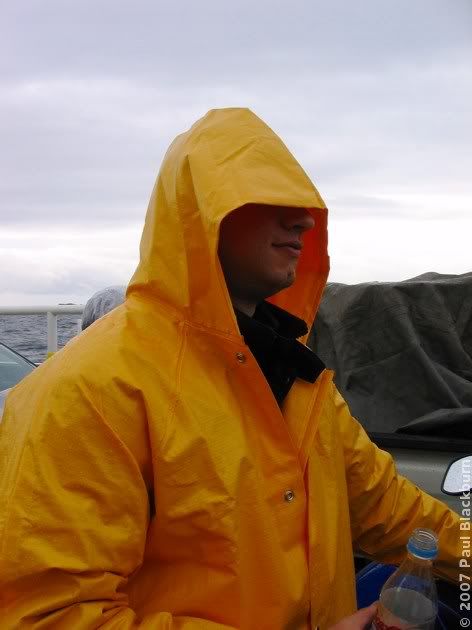
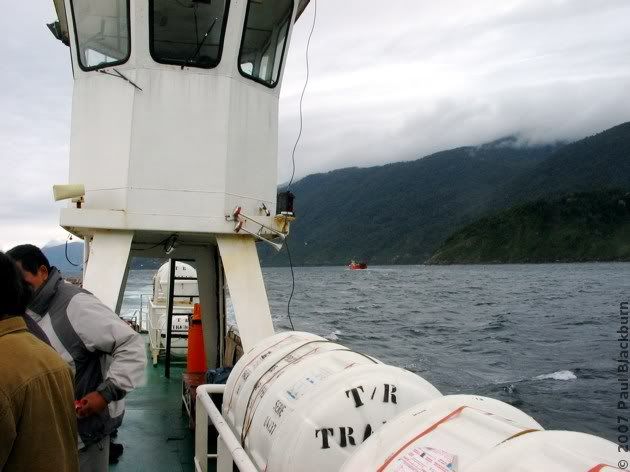

The ferry was swaying a bit, and both bikes were in risk of toppling over, particularly mine. Beside us, a large truck, rocking on its suspension with each wave. Unsettling, to say the least.
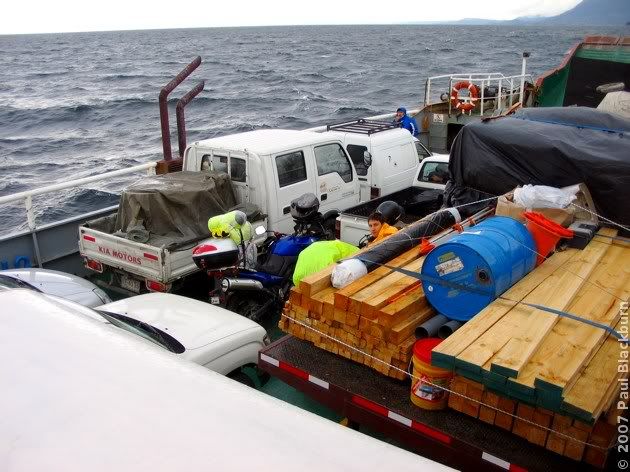
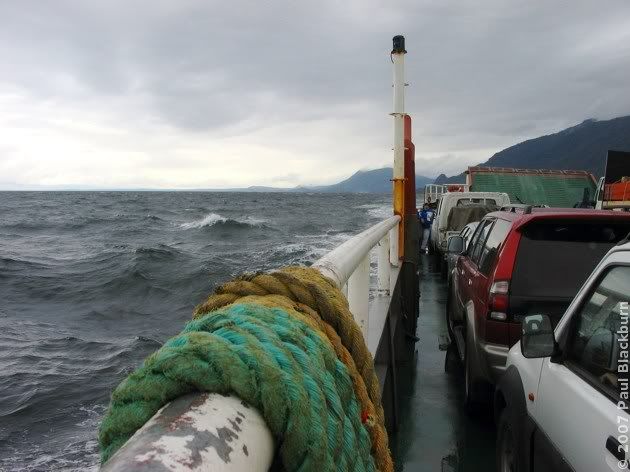
On the other end, about 50 km to Hornopirén.
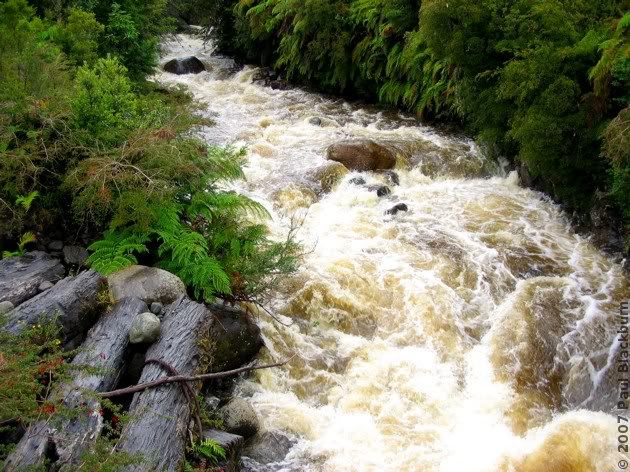
You can't really see it clearly, but down there by the river there's a wall of nalcas, giant-leaved plants that were a constant sight in the damp areas from this point on.
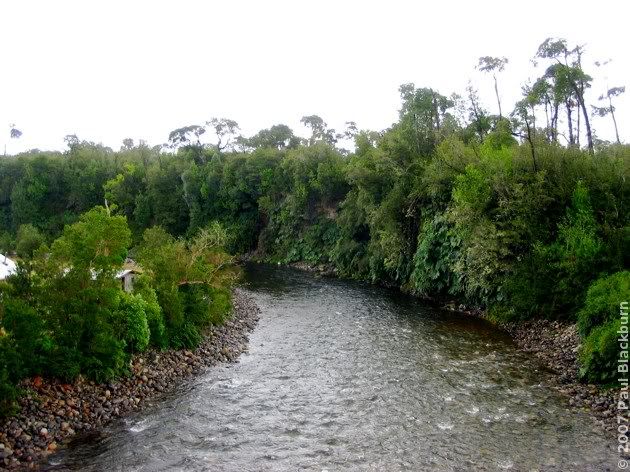

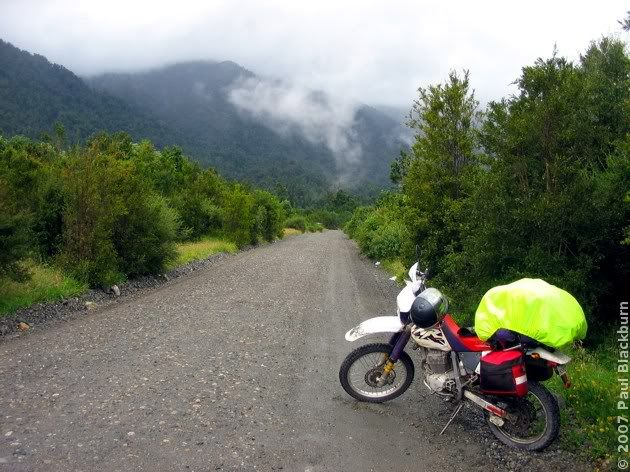
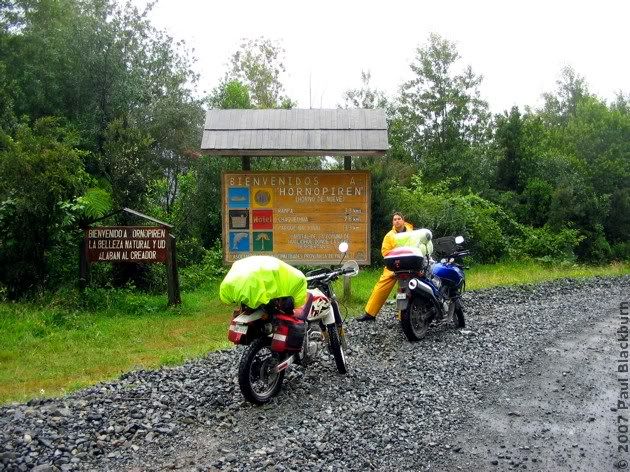
In Hornopirén, it rained still.
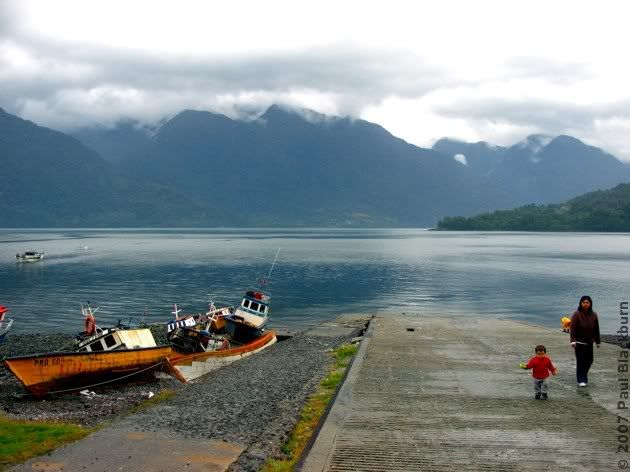
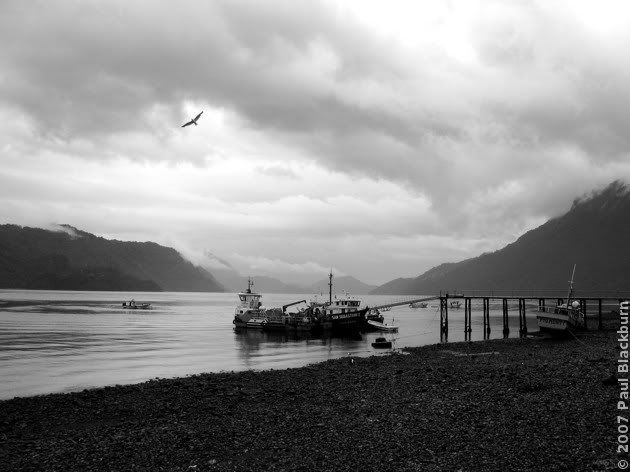


Since my bike was unloaded, I went for a spin.
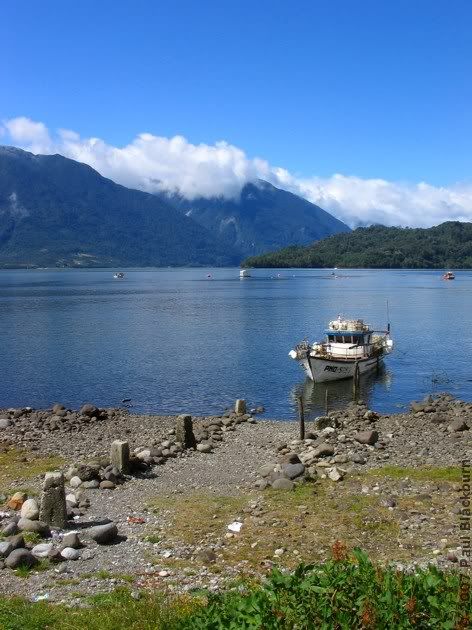
After the rain, sun!

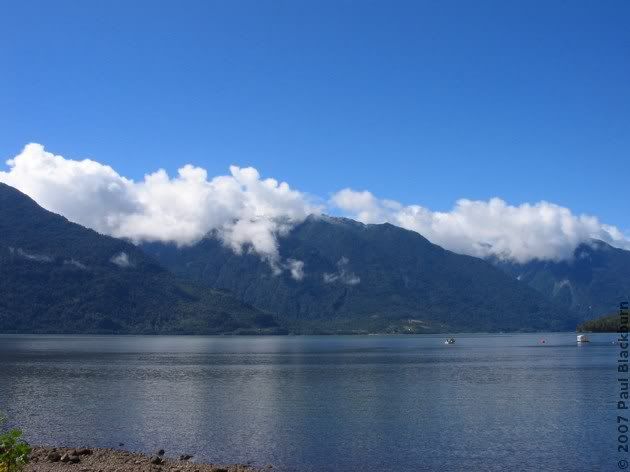

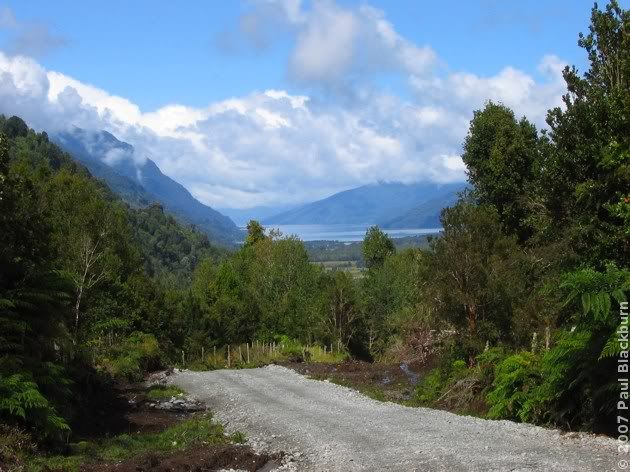
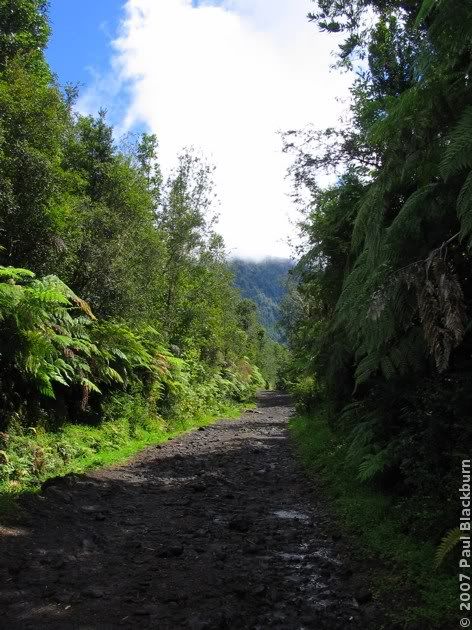
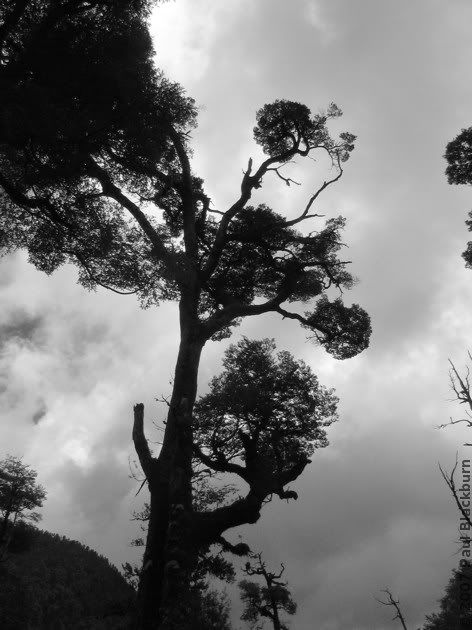

Coming down turned out to be easier than going up, and just as much fun. This is the house (and probably the family) of the guy that helped me.
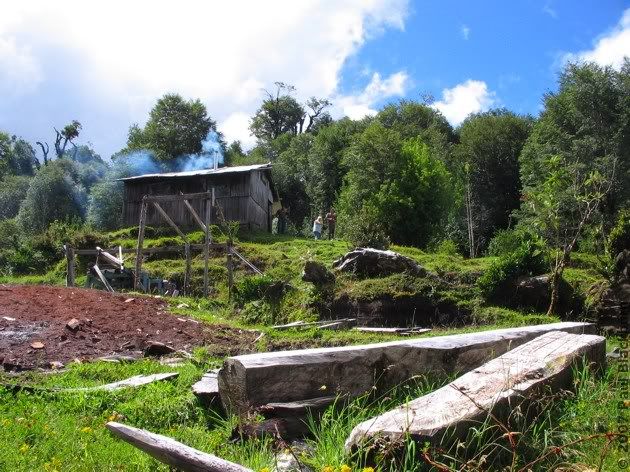
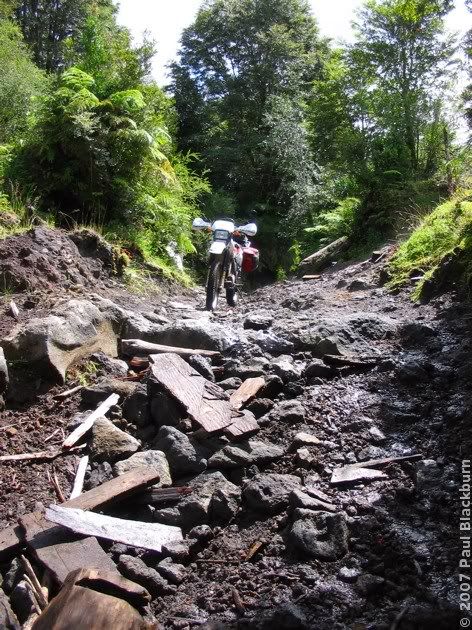
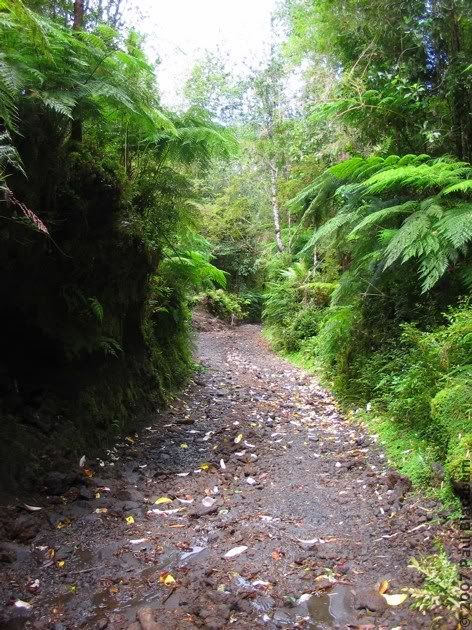
Soaked in sweat, covered in mud, volcanic sand and dead leaves, I arrived at the cabin, where Camilo was sunbathing or something equally unmanly. He set off to get a place in the ferry's queue, and I changed clothes and packed my stuff. I took off my jeans and put on some semi-water-resistant trousers I bought for cheap at a place that sells fireman and ambulance crew uniforms and kits, complete with reflective stripes around the trouser legs. My tshirt was soaked, so it got strapped to my luggage, and I just wore my bike jacket. Excuse me, miss, where's the bachelorette's party?
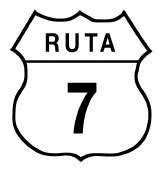 | Days 4 y 5: Pucón-Puerto Montt, Start of the Ruta 7, Hornopirén. |
Despite having gone to bed late, I woke up early. The tent was not sunlit. I could hear a soft, constant noise, the occasional crinkle of a plastic bag at another campsite, the clink of a fork a few tents off. What was that soft, constant noise then? My consciousness drifted here and there, compared it to the sound a TV makes when it gets no signal, and promptly shut down for another five minutes of dozing. My eyes popped open wide when I understood what the noise was: rain. Crap. That meant that we'd have to take everything apart and pack in the rain.
We did, and it was quite unpleasant. Somewhere in the pile of stuff that we had on top of and below the campsite's table (both slightly drier than everywhere else thanks to a tree) was my inflatable bed roll. I got it as a Christmas present, it's one of those thin ones that self-inflate. A few days later I realised I had lost it, most certainly hanging in the tree or tucked out of the rain under the table.
Wet and uncomfortable in our yellow rain suits, we set off. We didn't want to have anything to do with the scenery, turnoffs, tourist stops. We just wanted to get there as soon as possible.
And we did. Stopping at service stations every now and then, for food or fuel. On one of those stops some naive soul, glancing at the half-donned rain suits as we munched some food, actually asked Camilo if we were motorcycle delivery people. Ah, the wonders and mysteries of thy neighbour's mind...

One thousand kilometres from Santiago, and night fell.

We rode in to Puerto Montt quite late, and weren't too thrilled at what we managed to see of the city. We decided to stay at a hotel (Millahue), so we could dry our things and get good rest before the main leg of the journey. It was still raining.
The next morning we trudged over to the Easy home maintenance store to buy a few things. I got the unpleasant surprised that my waterproof gators, needed to complement my short touring boots, had had some sort of existential crisis, and were no longer waterproof. It seems the rubberized backing just dissolved. I wonder why, since they weren't a year old.
I decided to buy a few metres of polyethylene, transparent contact glue, 3M two-sided outdoors sticky tape. The plan was to extend my rain suit's trousers with all of this, since they rode up whenever I was on the bike. Camilo bought kitchen gloves (yes, those yellow rubber ones), since his gloves were getting soaked.
Before we left the room, I noticed that roof of the building next to the hotel had been used for some strange re-decorating sessions.

We set off in the rain towards Hornopirén. We were finally on the Camino Longitudinal Austral, the Ruta 7. We didn't know what to expect: mud, holes, washboard, giant rocks.

After about 60 km of riding we reached Caleta La Arena, where we took the first ferry. The queue of vehicles was quite long, but we just buzzed straight down to the loading ramp. Ah, the beauty of motorbikes. If you can't do this sort of thing where you live, it's time to pack up and ride across a border or two.
We bought the last empanadas we'd see for a while, which we had not time to finish before El Trauco came in.

It rained still.



The ferry was swaying a bit, and both bikes were in risk of toppling over, particularly mine. Beside us, a large truck, rocking on its suspension with each wave. Unsettling, to say the least.


On the other end, about 50 km to Hornopirén.

You can't really see it clearly, but down there by the river there's a wall of nalcas, giant-leaved plants that were a constant sight in the damp areas from this point on.

We had no way of knowing it then, but this segment of the Ruta 7 was a good approximation of what the rest of it would be like. The fears we might have had about mud turned out to be unfounded, and though some parts of the trip were harder than others, we never had serious road trouble (not considering the stretches of loose stones and strong crosswinds that make your palms sweat).
The greatest danger on the Ruta 7 are other vehicles. In many places the road is not wide enough for two vehicles to pass each other without having one of them slow down and brush the overhanging vegetation aside. Most parts of it were what one might call a three-track road, and some times gravel, stones or loose earth lay outside of these three tracks. That meant that having to leave the right-most track at high speed would result in a certain fall.


Sometimes the road was wide, flat and well packed. This was generally the case in areas of dense vegetation, where there was enough organic material in the road surface to keep things from turning nasty too quickly.

In Hornopirén, it rained still.

We rode up to the small office of Naviera Austral, but they were closed for lunch. There were many people parked on the narrow road that passed the office and led down to the loading ramp. Quite a few were standing about: a few families, a few young backpackers, a few foreign tourists. A young guy finally came out of the office, and by the way people looked at him, he probably worked there. A gringa asked a question in bad spanish, and so he answered in English. I barged in, speaking in English as well, and when he was no longer able to understand what I was saying, I switched back to Spanish. This seemed to surprise him and those around us. What, can't a guy have two native languages? Though I was not a pretty blonde, I had briefly been a gringo, and had my questions answered, but now that I was merely a chileno, he gave me the cold shoulder and buggered off down the few slick wooden steps, into the tiny garden, out the small rusty gate, and disappeared in the general direction of the tiny cluster of trinket and homemade food stalls. A first taste of what we would later learn is Naviera Austral's modus operandi.

There was no space on the ferry that day, and there were people in Hornopirén who had to wait three or four days for a ticket. Luckily we were able to get something for the next day, again thanks to the fact that were were a pair of motorbikes and not something larger.
That night we visited every single hardware store in Hornopirén, searching for a 12 mm allen wrench. Camilo needed it to take the front wheel off, should he get a flat. We came across what must be the best-equipped small-town hardware store we've ever seen. Bicycle brake lines, chains, wrench sockets, nails, glues, lubricants, license plate frames, rolls of wire, netting, the list just went on and on. And Camilo found what he was looking for, so after chatting to the nice guy behind the counter, we were off to the supermarket to find something to eat.

I open my eyes and turn the cellphone's alarm off one final time.
The constant purr of the small gas heater, the cold air, and the two blankets on my bed are not something that I'd normally need in February. Outside it is softly raining. Anything in the room that might serve as a hook (including the curtain rails) has at least two damp things hanging off it, drying. Camilo is still asleep. I peek through the curtains. There are the bikes: soaked, bits of mud and sand stuck to them. If I visually follow the narrow path up to the cabin into the distance, over the trees and bushes, I can see the black silhouettes of the hills, covered in dense vegetation.
At that moment the clouds part slightly. The room is now slightly lighter, a shadow here and there become more defined. On the bikes, a few drops manage a glimmer. And then the clouds close up again. I have a feeling that was the only bit of sun I'll see all day.

Since my bike was unloaded, I went for a spin.

After the rain, sun!


I went up a small dirt road towards the Parque Nacional Hornopirén, passing through the small town of Chaqueihua. The road ended in front of a saw mill, and further on, a wooden gate across the entrance of a place that looked very much like private property, though it was apparently the way in to the park. I glanced at the map again. My desire to reach the Lago General Pinto Concha was not to be fulfilled. (Spanish speakers will understand my motivation :-).


At the saw mill I was told that there is another road that went all the way up to another lake. The road was not an easy one, but you could do it on a motorbike. So off I went.
And yes, the road was indeed a 4x4-only trail. Large volcanic rocks, loose and part of the ground made riding hard but very, very fun.



Up and up I went, riding gleefully through muddy puddles that covered the crank case, gassing it over unreasonably sharp and gigantic rocks, I came to a place that was almost impossible to do if you weren't coming at it fast. (Never forget the difference between attempting to get over an obstacle using the engine alone, versus the engine plus your inertia). I lost speed, and nearly went over to my left, in one of those nearly-nearlies at 0 km/h.
The Polo brand gators that I was wearing (in case of rain and as a substitute for my other ones) were ripped to shreds after kicking and slipping on the sharp volcanic rocks. With the kind help of a guy that came out of nowhere I was able to push the bike up over the hard part and carry on. Soaked in sweat (because I was in my rain trousers), I pushed on.
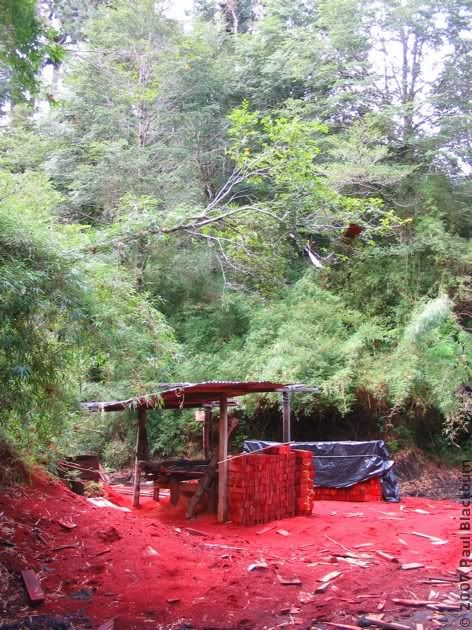
After more puddles, mud and all the rest, I decided to stop. The trail had become ridiculously steep and irregular, to the point that I was not sure whether I could safely come back down it without a problem. The visit to lake Cabrera was therefore left for another day.

Coming down turned out to be easier than going up, and just as much fun. This is the house (and probably the family) of the guy that helped me.

And this is the hard part. The picture was taken looking up the slope, so the horizon is really about where the rocks between the diagonal boards are, in the lowr third of the picture.


We boarded without a hitch, and they tied the bikes down with clicky straps. When everyone was aboard, a family on the ferry's frontal loading ramp was still arguing with the crew. "We have a reservation, we have purchased tickets that show our vehicle's license plate, the ticket is for today, and you're not letting us onboard". The crew member just said that they'd better get off the ramp, because the boat was about to set sail. And with that, by raising the loading ramp, the argument was over. A gentleman leaned over and commented, upon observing all of this, that this scene was one that happened time and time again. "No, this always happens. It's a shame". Long live Naviera Austral.
Next Chapter: Caleta Gonzalo to La Junta.
Labels: carreteraaustral, rides, trips

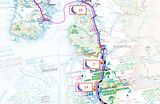
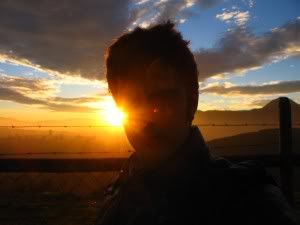
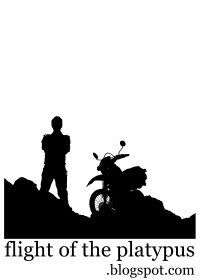

 The Lagoons of the Santuario de la Naturaleza 2: Laguna Los Ángeles
The Lagoons of the Santuario de la Naturaleza 2: Laguna Los Ángeles Race Day At Leyda 4
Race Day At Leyda 4 El Tabo and the Central Hidroeléctrica El Sauce
El Tabo and the Central Hidroeléctrica El Sauce Exploring The Hills Around Lampa
Exploring The Hills Around Lampa A Different Route To Baños De Colina
A Different Route To Baños De Colina The Mines of the Cuesta La Dormida
The Mines of the Cuesta La Dormida The Frozen Lagoons of the Santuario de la Naturaleza
The Frozen Lagoons of the Santuario de la Naturaleza Second Mass Demonstration "For A Fair Tag"
Second Mass Demonstration "For A Fair Tag" First Mass Demonstration Against The 'Tag'
First Mass Demonstration Against The 'Tag' Enduro In Lagunillas
Enduro In Lagunillas Embalse El Yeso and Termas Del Plomo
Embalse El Yeso and Termas Del Plomo Ride To Peñuelas
Ride To Peñuelas Cerro Chena
Cerro Chena Race Day at Leyda 3
Race Day at Leyda 3 Baños de Colina 2
Baños de Colina 2 Carretera Austral: Epilogue
Carretera Austral: Epilogue The Little Giant and Termas del Plomo
The Little Giant and Termas del Plomo Back on Two Wheels
Back on Two Wheels 2006 Photographic Retrospective
2006 Photographic Retrospective Race Day At Leyda 2
Race Day At Leyda 2  Quantum Optics III in Pucón
Quantum Optics III in Pucón Meseta In Chicureo
Meseta In Chicureo Pick Up Your Beer Bottle And Fuck Off
Pick Up Your Beer Bottle And Fuck Off  Planes And Hills
Planes And Hills Cut-Off Road
Cut-Off Road Lagunillas
Lagunillas Laguna Verde 2
Laguna Verde 2 Ride To Anywhere But Aculeo
Ride To Anywhere But Aculeo Cerro El Roble, Second Attempt
Cerro El Roble, Second Attempt Baños De Colina
Baños De Colina Some Walk On Water...
Some Walk On Water... Race Day At Leyda
Race Day At Leyda Almost Cerro El Roble
Almost Cerro El Roble Off To Curacaví with Andrés
Off To Curacaví with Andrés La Serena, Part 3: Back To Santiago
La Serena, Part 3: Back To Santiago  A Bull, Two Cows and a Chilean Fox
A Bull, Two Cows and a Chilean Fox Escape To Cuesta La Dormida
Escape To Cuesta La Dormida Valve Adjustment
Valve Adjustment La Serena, Part 2B: Valle Del Elqui
La Serena, Part 2B: Valle Del Elqui La Serena, Part 2A: Coquimbo and La Recova
La Serena, Part 2A: Coquimbo and La Recova Mud And Pine Trees
Mud And Pine Trees La Serena, Part 1
La Serena, Part 1 Pimp My Exhaust
Pimp My Exhaust Ride To Laguna Verde
Ride To Laguna Verde Ride To La Mina
Ride To La Mina Ride To Termas El Plomo
Ride To Termas El Plomo Camping in Colliguay
Camping in Colliguay Ride To Portillo
Ride To Portillo Ride To Olmué and Con Con
Ride To Olmué and Con Con Siete Tazas
Siete Tazas Watching The Departure Of The Day That Brought Me Here
Watching The Departure Of The Day That Brought Me Here Buenos Aires Motorbikes
Buenos Aires Motorbikes Ride to Talca with the Adach Group
Ride to Talca with the Adach Group Las Trancas '05
Las Trancas '05 Towers and Hills
Towers and Hills María Pinto, Melipilla, Aculeo
María Pinto, Melipilla, Aculeo Me and my Carb
Me and my Carb




0 Comments:
Post a Comment
<< Home